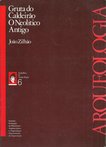 |
António João Cruz, "O teor em flúor nos ossos da gruta do Caldeirão", in João Zilhão (ed.), Gruta do Caldeirão. O Neolítico Antigo, Lisboa, Instituto Português do Património Arquitectónico e Arqueológico, 1992, ISBN 0-972-9374-00-07, pp. 217-222 |
| Abstract |
At Gruta do Caldeirão, layer Ea, which was thought to have been deposited in Early Neolithic times, contained some bones that were thought to be derived from the underlying Paleolithic stratigraphic units; layer Eb, which was thought to have been deposited in Late Paleolithic times, contained bones that were thought to be intrusive from an overlying Early Neolithic occupation. These diagnosis were based on the analysis of the surface appearance of the bones (Zilhão, chapters 3 and 4). Fluorine content determinations were undertaken to seek support for them. The results obtained showed that, for bones considered to be in situ in layers Ea, Eb and Fa, there was a steady increase in fluorine content with depth, that is, with time, and that a distinctive cluster of values characterized each one of these three layers (Tables 1 and 2). One bone (sample 10), thought to be of Neolithic age and therefore intrusive in layer Eb, had a fluorine content much lower than the in situ Paleolithic Eb bones; one bone (sample 12), thought to be of Paleolithic age and therefore in a disturbed position in layer Ea, had a fluorine content much higher than the in situ Neolithic Ea bones; sample 11 gave an anomalous result due to its high porosity (Table 3). |
